Election 2024 [3]: How the IFP survived Buthelezi’s disastrous leadership
by The Editor

A Thread: “How the IFP survived Buthelezi’s disastrous leadership”. This thread explores the IFP’s electoral record nationally and, in detail, in KZN , along with its decline under Buthelezi and small revival in 2019 (with nice graphs!)
How the IFP survived Buthelezi’s disastrous leadership
By: Gareth van Onselen
Follow @GvanOnselen
4 January 2024
This essay is the 3rd in an on-going series on Election 2024, for all other editions of this series, please click here: Election 2024
The big picture: This graph (below) maps the IFP’s national electoral performance in each national and local election since 1994. There was, for a long time, a dramatic decline in the IFP’s vote share but, since 2014, it has started to tick upwards.
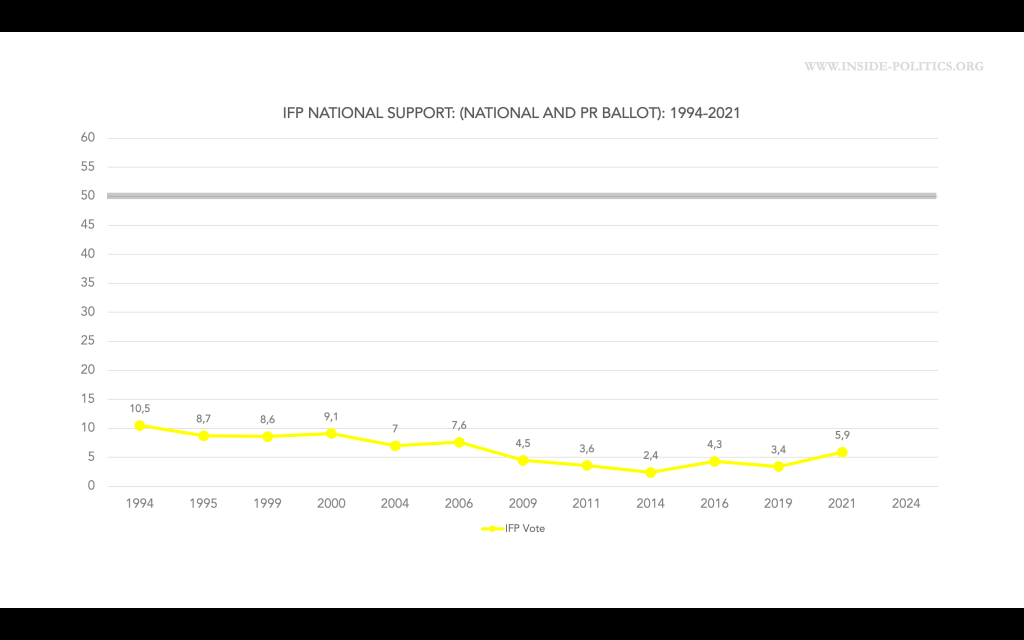
If we use the IFP’s performance on the national and provincial ballot only (to check for vote splitting) we get this graph (below). As you can see, the two ballots track each other almost exactly.
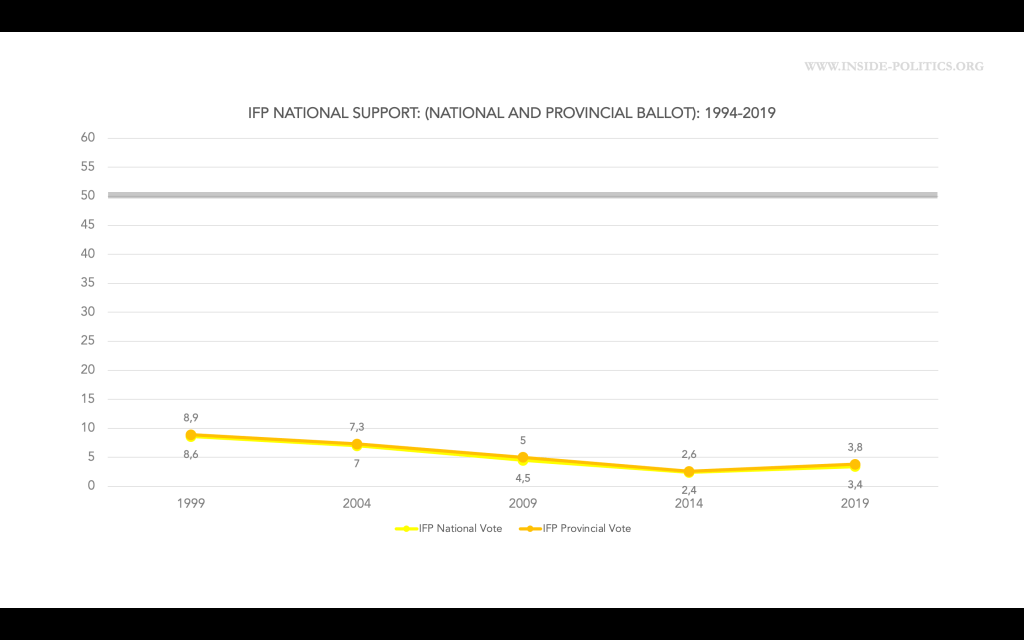
Why is this? The fundamental reason is that the IFP is essentially a provincial party. It only exists, in any meaningful way, in KZN; despite the IFP’s pretense it is a national party. This might seem obvious, but the extent to which it relies on KZN is worth setting out.
This table (below) sets out every IFP provincial result for each national election since 1994. There is a lot to say about this table. The most important point is, every election, around 90% of the IFP vote comes from KZN. It lives or dies by this provincial performance.
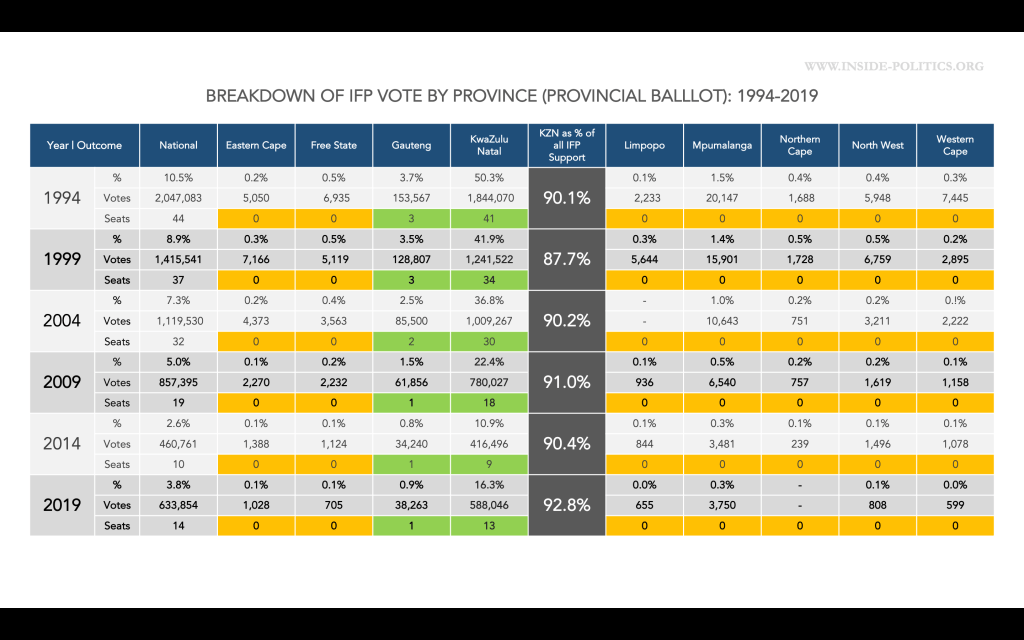
Second, there are seven provinces were the IFP has never won a provincial seat, in six national elections. And, despite its uptick in 2019, it is more reliant on KZN than ever before. 93% of all its provincial ballot support in 2019 came from KZN, the most ever.
Outside of KZN, what miniscule support the IFP had, has diminished to the point of vanishing. In 2019 it got 0.1% in three provinces, effectively 0.0% in two others, and in one it did not even stand. Why it contests provinces outside KZN at all is a mystery.
The third point, implicit to that table, is an unmitigated electoral disaster spanning 20 years, and some hard questions to be asked about the leadership of the late Mangosuthu Buthelezi.
Let us look at his record in a bit more detail. In terms of electoral performance, Buthelezi was the worst political leader South Africa has ever had, post democracy. Here is a graph (below) setting out the IFP’s electoral performance in KZN.

And here is the same graph for the IFP’s KZN provincial ballot performance only. Under Buthelezi, the IFP dropped 39 pts, from its electoral high (in 1994, a 50% majority), to its electoral low point (in 2014, of just 10.9%).

This graphic (below) sets out the full decline. Between 94 and 2014, the IFP lost 1.4m votes or 77% of all its 1994 support. Yes, the election of Zuma did exacerbate the IFP’s problems, but even before Zuma was ANC president, the IFP lost 834k votes or 45% of all its 1994 support.
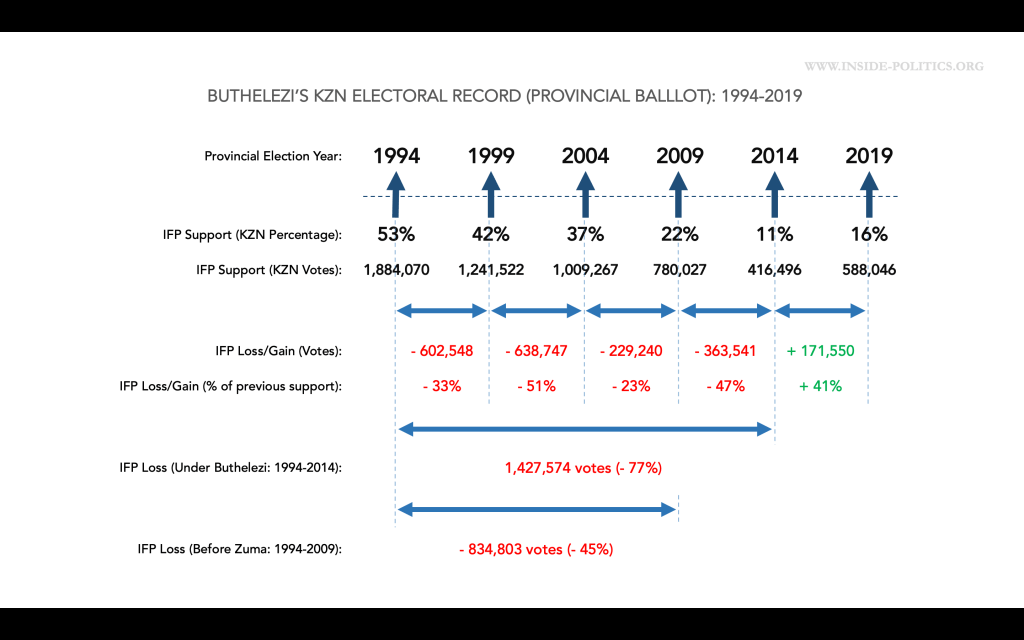
It is remarkable how Buthelezi escaped accountability for this. When one considers the pressure on parties like the DA, and given the IFP’s 1994 potential, his legacy as a political leader is generally without assessment of a core leadership currency: votes won. By that measure, he misspent a fortune and was basically bankrupt at his retirement.
But how did the IFP collapse? This is important to understanding current dynamics in KZN. The long and the short of it is: The ANC put a noose around the IFP in rural KZN and, from 2006 to 2014, squeezed it down to down to its last breath.
It is rare to get a graph like this (below). It shows the IFP’s and ANC’s provincial performance in KZN, in each local and national election since 1994. They mirror each other almost perfectly. ANC goes up, IFP goes down, and vice versa, a totally symbiotic relationship.

There is a better way to illustrate the ANC’s stranglehold. The IEC has a map for each provincial election, showing support in colour by ward. If we line them up from left to right (as below) we can see how the ANC green surrounds the IFP orange and squeezes it over time, and until 2014. In 2019, the IFP fights back, and starts to expand its circle.
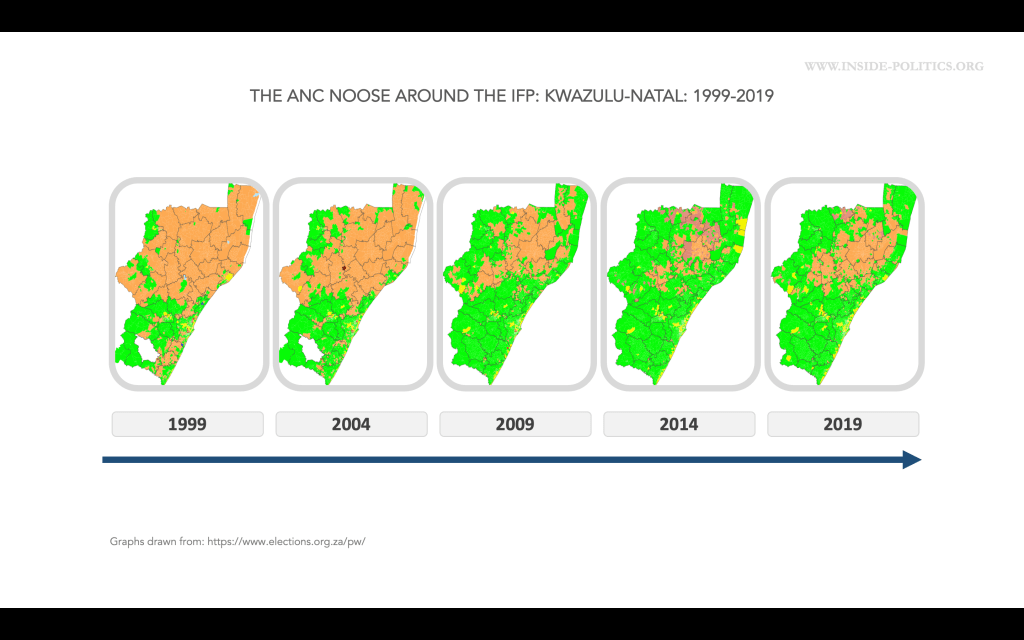
So, the IFP’s current situation looks as per the below. The IFP stronghold is in dark orange, the light orange outer ring is the battlefront with the ANC. In 2024, the IFP will be looking to make this outer ring dark orange too, as it seeks to continue expanding.

How is it doing? Well, we can map the IFP’s and ANC’s 2023 KZN by-election ward wins onto the map (as below) and you can see that there are promising signs for IFP – it is winning wards inside and outside the battlefront, suggesting it can expand its circle further still in 2024.
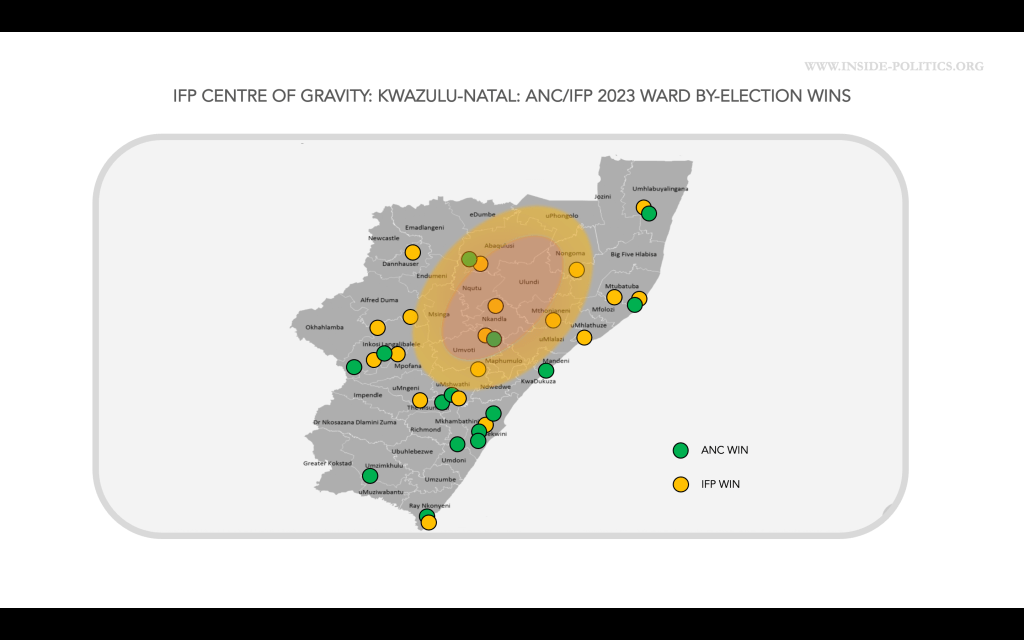
Now, to be clear, this map is designed to make a general point (not every dot on that map is equal, sometimes the ANC wins 3 wards and the IFP one, but they each get one dot). The general point is, there are strong indications the ANC stranglehold, at least, remains broken, and some clear potential for it to grow into ANC territory.
It does not account for IFP support that might have improved, but nevertheless did not result in a ward win. That too is an important sign. But if the IFP is winning wards, you can be sure its support is generally mirroring that.
It is tempting to attribute all changes in IFP and ANC support to only these two parties eating away at each other. But KZN politics is complicated, and there are two other factors to bear in mind, namely the EFF and NFP.
The EFF, like the IFP in recent times, is also likely eating away at the ANC’s KZN vote. This graph (below) shows the EFF’s KZN support mapped against the ANC’s. As you can see, the EFF’s support mirrors the ANC’s decline.

This graph (below) shows the NFP’s support. Although the IFP was already in serious decline before the NFP came along, it clearly took a chunk out of the IFP. It has been decimated since, but you can be sure some of the IFP’s 2019 growth came from the NFP.

The NFP is important when considering the IFP’s recent growth. We don’t know to what extent the IFP of 2024 is eating into the ANC. There is a strong chance a large part of its 2019 bump came from the NFP, which is worth bearing in mind.
So, if you want a big picture, that gives you a general idea of how the rural and peri urban KZN vote has gone over the last decade, below is one that summarizes it. The ANC and IFP eat each other, and the EFF and NFP eat away at the ANC and IFP respectively.

Finally, turnout. This graph (below) shows KZN provincial turnout against the IFP’s support. The IFP’s decline mirrors the drop in turnout, until 2019, when it bucked the trend, and grew its support faster than the decline in turnout. That was exceptional in 2019.
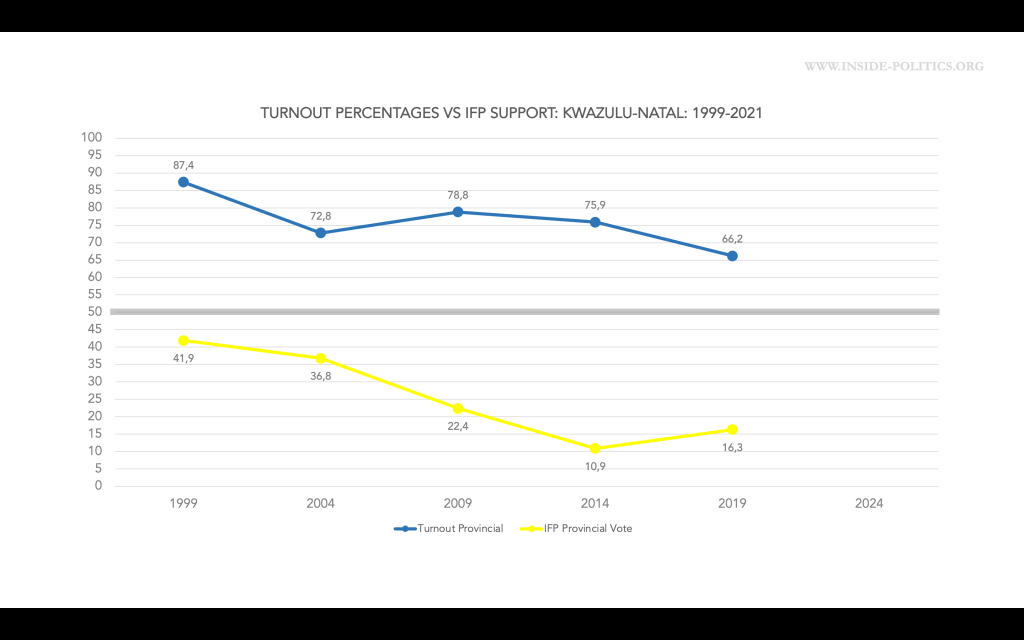
This is further evidenced by the following graph (below) which shows the IFP’s provincial support against all registered voters in KZN. Again, the IFP vote shrinks dramatically from 36% of all registered voters down to 8% in 2014, but then grows incrementally. Another good sign for the IFP.

Two things are obviously missing from this analysis. One is the DA, but its KZN performance is complicated, also generally more urban, and requires its own analysis. The other is the advent of Zuma’s MK party, but that too I shall look at separately, down the line.
So, what are the key macro take-aways from this particular analysis?
- Former IFP leader Mangosuthu Buthelezi oversaw the worst electoral performance ever in post-democratic South Africa. Under him, the IFP lost 77% of its 1994 support, or 1.4m votes. His electoral tenure for the IFP was catastrophically bad.
- The IFP lost support primarily to the ANC, which encircled the IFP in rural KZN, and squeezed it down to a fraction of its size. But it has started to grow and 2023 by-elections suggest it can now fight and beat the ANC beyond its stronghold.
- However, the EFF and the NFP are important factors in this battle too. The EFF is likely eating away at the ANC, and the IFP’s growth in 2019 was likely bolstered by the NFP’s decline. Whether the IFP can take a further meaningful chunk out of the ANC remains to be seen.
- After a 20 year decline, the IFP grew in 2019, albeit incrementally. However, even the pretence that the IFP is a national party is now meaningless. It is wholly reliant on KZN. 93% of all its provincial ballot support in 2019 came from KZN, the most ever.
- By way of illustration, there are seven provinces were the IFP has never won a provincial seat, in six national elections. In 2019 it got 0.1% in three provinces, effectively 0.0% in two others, and in one it did not even stand.
- Encouragingly for the IFP, its 2019 electoral performance was significant because it bucked two widespread trends: it grew faster than turnout declined, and it grew its proportion of all registered KZN voters.
- If the IFP is serious about national politics, it needs to dramatically reconsider its approach. Where it once had a small national foothold outside KZN, it now isn’t even holding on by its fingernails. In 2024, as ever for the IFP, its KZN or bust.
All numbers in this essay are drawn from: https://www.elections.org.za/pw/
This essay is the 3rd in an on-going series on Election 2024, for all other editions of this series, please click here: Election 2024

You must be logged in to post a comment.